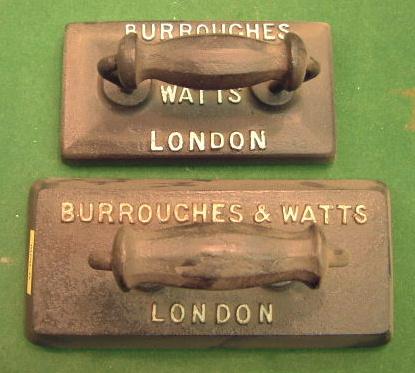It is not clear as to when the habit of ironing the cloth first started, but the use of the iron is documented in many books of the latter part of the eighteen hundreds. I think it is safe to assume that once cloth was introduced to the bed of the table it would need to be ironed to keep it as flat and smooth as possible.
The use of the iron has been with us for more than one hundred years, and probably a lot longer. Most of the irons I have come across date from the late nineteenth century and into the early twentieth century.
The early table iron either had a solid cast iron base to it, which was heated up on a fire, stove top or gas burner, or it had a loose “slug” of iron. The slug was basically an oblong length of metal that was heated outside of the iron, then placed into a cavity of the same shape to heat up the iron.
Almost every major manufacturer had irons cast for them with their names embossed on the top part of the iron. Many irons can be found with exactly the same shape base and handles so it can be safely presumed that a foundry would have used the same mould to produce irons for several different table manufactures, just changing the company name on the top.
The solid iron can sometimes be found with its original tin sleeve that was used to protect the iron’s surface while not being used, although the majority of irons tend to turn up with out this nice addition.
I have seen a Special gas burner with a slotted space made on the top to fit two irons, warming them both at the same time. This presumably was for a club with several tables so that they would have a continuous stream of hot irons, rather than having to wait for one iron to be heated before another could take it’s place.
The standard solid table iron can be found fairly easily even if more often than not it does turn up heavily pitted, but once it is cleaned and polished it can make a nice addition to a period Billiard room, if rather heavy for shelving!
The most common use for an old iron amongst ordinary folk not yet initiated into our world of Billiard memorabilia collecting is for them to be used as doorstops. Many of the ones I own have been sold to me by eager antique dealers desperate to rid themselves of the burden of having to carry this heavy weight from fair to fair, declaring that “They make the perfect doorstop mate!”
Electrical irons would not have been in common use until after the Second World War when the distribution of electricity had become widespread enough throughout the country.
The manufacture of the electric iron must have been far more expensive than the basic cast metal iron, the cost to the customer would have reflected that. So many clubs would probably have remained with the old faithful irons well into the nineteen fifties rather than splash out on new electric versions.
My thanks to Mr Peter Clare of Thurston for access to some of his collection.
David Thomas Lyttleton










